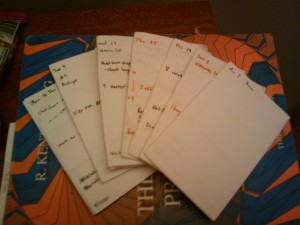Have you ever scheduled something and then remembered you had another appointment? Have you ever had a big block of time or energy and wasted it, neither resting nor accomplishing anything?
Earlier this year I started a new near-weekly ritual. I used a tool that I found useful in college for busy weeks. The fold calendar is a way of quickly visualizing a week and using it effectively. Here’s what the daily entries might look like:

Basically, it lists the events of the day in chronological order, with times if I have them. It lists the main project that I want to advance this week and a couple of smaller tasks that I’d like to get done. For context, I list the big things that are happening next week as well.
Why is this useful?
This tool is useful because it:
- helps visualize and use chunks of time
- helps with being spontaneous
- helps with being organized
- helps budget time and energy
Skip down to the last section to learn how to build your own calendar, or keep reading for more context.
Be productive (or not!)
The key to the fold calendar is identifying blocks of time that are prime for doing things, and listing the important things that I want to do.
I then look at the week and see how many blocks I have, what I need to get done, and what I want to get done. I estimate how long things will take and tentatively schedule some of the “must” items. For example, if I know that I have a small milestone due on Thursday, I will need to use one of the blocks before then to complete the milestone.
Sometimes I only have a few blocks during the week after scheduling everything else. When I realize this, I make better use of these blocks. “I won’t have another chance to work on this until next week, so let’s try to focus for the next hour and see what I can do.” It’s really motivating to me to know how many hours I have in the week to really devote to side projects. Typically there are fewer hours than I would have thought. If I’m not aware of how little time I actually have, I tend to squander this time or become despondent because I feel that I should be achieving more with my life. If something is going to get done this week, it probably needs to fit in the buckets I identified by making and using the calendar. I know how much time each bucket has, and so will start something that I think I can finish in the time and energy I have. This technique respects the spirit of GTD and could be useful with a personal kanban as well.
Balance
On the flip side, when I am aware the things that really matter this week, I can leave blocks unscheduled and then am free to relax without worrying about getting things done. It’s definitely important to have recreation, and having a large block of guilt-free, uninterrupted relaxation is great. It’s purposeful recreation–re-creation. Being aware of the time and using it to restore balance and energy.
Also, I think that this is useful in consciously deciding how to spend time. If I see a free concert that I could go to, I need to decide whether it will be worth my time and energy to go. Having the fold calendar might allow me to see that I should do it because the second half of the week is pretty full and I will need to rest. It could instead indicate that the concert cuts up a huge six hour block that I could instead use productively.
The flip fold calendar might be one of the most important tools for me to advance side projects. Most of the time, side projects don’t have a deadline. There will always be other things to fill up the time. If you don’t believe this, read the big rocks story. Zen Habits also has an article that is along these lines. So the fold calendar helps prevent the seemingly-urgent from nibbling away at our core time. The “week-as-an-integrated-whole” mindset is what separates the fold calendar from normal calendars. Daily planning is useful, but it’s easy to find excuses. If I don’t get something done today, there’s always “someday soon”. But if I commit to doing something this week and it still does not get done, there is probably a more systemic problem that I need to address.
Clearly the calendar is useful for remembering meetings and engagements. The “next week” field gives a little more context and frees the mind from worrying about things that are coming up.
Your turn
Ready to create your own flip-fold calendar? It’s easy and inexpensive to make with things you already have on hand. Here are some things to consider.
- Take a piece of letter-sized paper and fold it into eight sections.
- Label the first seven sections with the day of the week and date of Monday through Sunday
- In the eighth pane, list ‘Key Project’, 'Smaller Items’, and 'Next Week’ as sections
- Go through your calendars (work, personal, shared, etc.) and write down scheduled events as they happen throughout the day
- Schedule exercise, grocery shopping, laundry, significant other engagements, and weekly planning time
- Identify energy-sapping periods, try to minimize them, and budget pre- and post-recovery time
- Identify blocks of time that you can devote to projects, cutting smaller things
It doesn’t need to be perfect, it’s just a tool. :) Hope you find it as useful as I have!
Have you used a system or tool like this? What were your results?